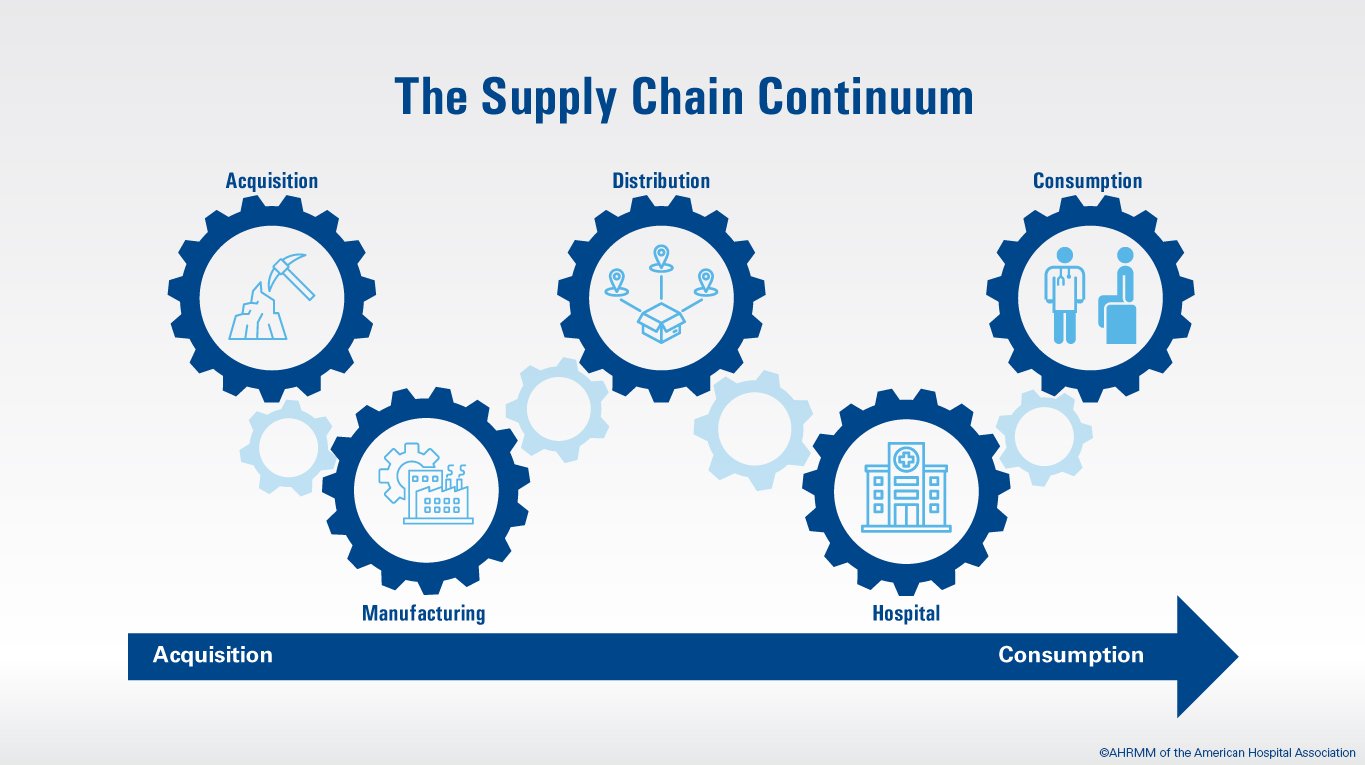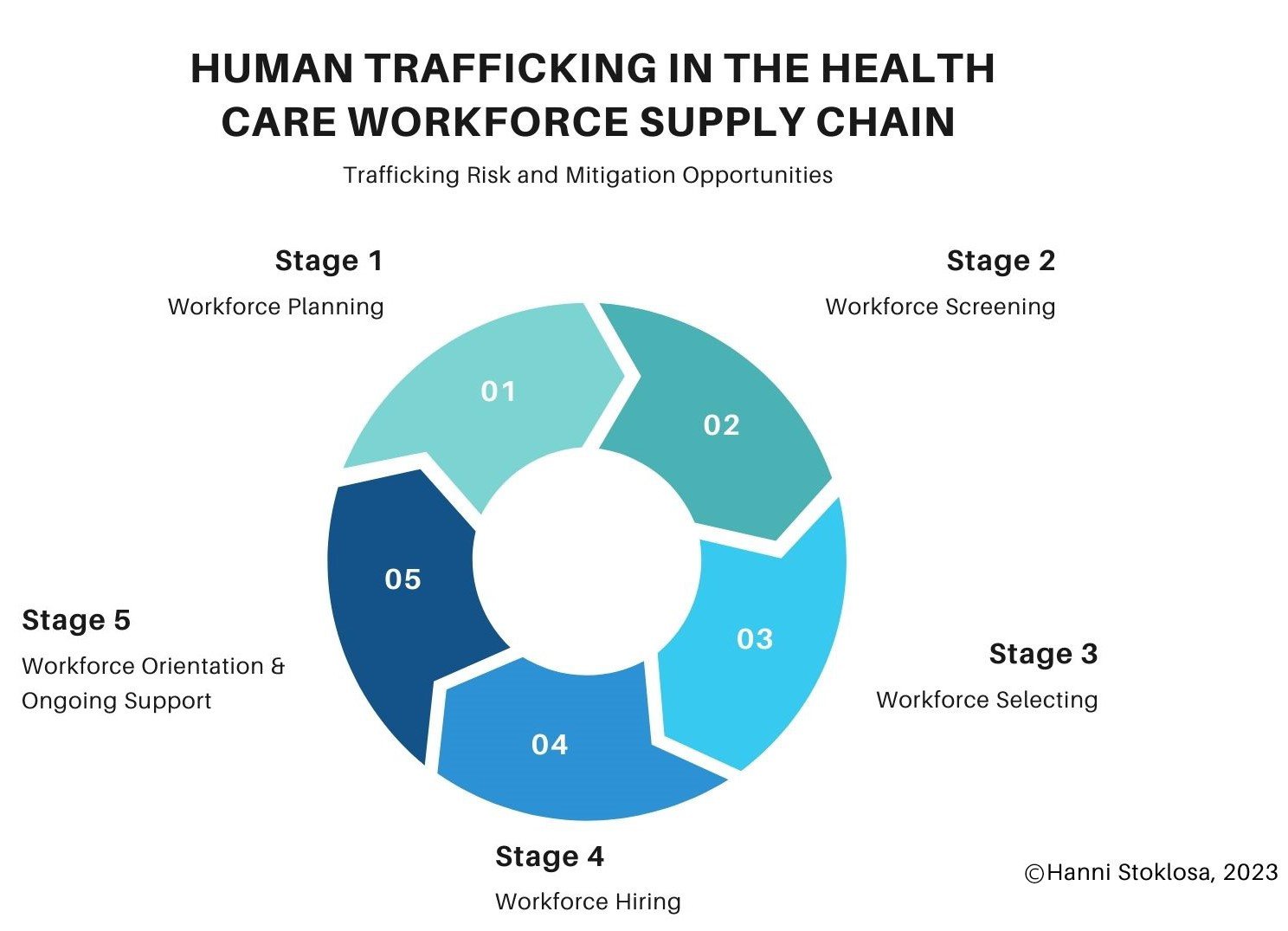Abstract
There has been little attention given to roles played by human trafficking in health care organizations’ supply chains. Hand sanitizers and gloves, for example, might be produced by forced labor, which tends to increase in prevalence during pandemics, mass violence, migration, or other global crises. This article considers the nature and scope of health care organizations’ corporate and social responsibilities to procure products and personnel justly, offers recommendations to minimize possibilities that supplies are produced by forced labor, and advocates for a public health approach to limiting human trafficking in organizations’ supply chains.
Introduction
Human trafficking is an egregious human rights violation.1 The United Nations Office on Drugs and Crime defines human trafficking as the act of “recruitment, transportation, transfer, harbouring or receipt of people,” by means of threat or use of force, fraud, or coercion for the purpose of exploitation.2 The Victims of Trafficking and Violence Protection Act, passed into law in 2000 by the US Congress,3,4 recognizes 2 different types of human trafficking: sex trafficking and labor trafficking. While sex trafficking can be considered a form of labor trafficking in some contexts, not all labor trafficking includes sexual exploitation. A primary goal of this paper is to call attention to human trafficking in labor and supply chains in health systems; thus, we will be focusing primarily on labor trafficking.
For purposes of this paper, labor trafficking or forced labor refers to the trafficking of individuals for forced labor that is not sexual in nature. Worldwide, 27.6 million people in 2021 were in forced labor situations.5 There are several forms of labor trafficking, including bonded labor, forced labor, and child labor.6 Victims of labor trafficking can come from any racial, ethnic, age, gender, religious, or socioeconomic group.7 However, certain factors make individuals more vulnerable to labor exploitation than others. These include questionable immigration status, language barriers, poverty, and limited social supports, as well as mental health and medical issues.7 Moreover, forced labor may become more prevalent in times of global crises, such as pandemics, mass violence, or migration, when there may be concomitant acute demands for hospital-based products and staff, as occurred during the COVID-19 pandemic, which exacerbated acute demands for personal protective equipment, masks, gloves, and hand sanitizer.8 Often described as a form of modern-day slavery, labor trafficking is a fundamental violation of human rights and necessitates a public health response focused on primary and secondary efforts.9
Fortunately, recently there have been calls to action for health care professionals to become more educated about human trafficking and its medical, social, and psychological effects on victims and for health care organizations and clinicians to take a more collaborative and interdisciplinary approach to addressing human trafficking.10,11,12 What is less appreciated by health care organizations and professionals are upstream opportunities to prevent human trafficking through thoughtful approaches to both goods purchased and services contracted. Here, we use a human rights lens to highlight the social and corporate responsibility of health care systems in acquiring products. One of our goals for this call to action is to describe ways in which health care leaders can implement solutions to mitigate forced labor and human trafficking risk in logistics and supply chains. Health care workers of all professions and disciplines will want assurance that health care organizations and their leaders are doing everything they can to ensure that any products purchased do not result from forced labor practices.
Health Care Organizational Supply Chains
Besides direct service provision to patients, resource procurement can be service- or product-based. Service procurement includes health care workers, building and resource management, food and beverage, housekeeping, and groundskeeping.13,14 Product procurement involves products, supplies, equipment, and related services and may include the commissioning of the construction or renovation of health facilities.13
In 2013, US hospitals spent an average of $3.8 million on supply expenses, which accounted for approximately 15% of total hospital expenses.15 Goods supply expenses are the second largest cost category for hospitals after personnel expenses.16 These figures suggest that health care organizations can have great influence on medical supply companies’ hiring and product procurement processes by demanding that the companies that they purchase from adhere to protocols that protect workers’ rights and mitigate labor trafficking. Health care organizations could also prioritize partnerships with companies that are located in lower-income countries and that provide safe and healthy working conditions and actively invest in those countries’ economies. These kinds of partnerships highlight how the health care industry can influence working conditions and improve the lives of its employees. Health care organizations need vigilance and determination to vet the products used with regard to how they are developed and transported. Ethical product and services sourcing is a social responsibility of health care organizations.17
Oversight
Individuals in the health care and public health (HPH) sector workforce may encounter forced labor at any stage of the supply chain (see Figure 1 and Figure 2). According to the International Labor Organization, indicators of forced labor include deception, restriction of movement, intimidation and threats, retention of identity documents, and debt bondage.18 HPH organizations may inadvertently facilitate and even benefit from these abuses through product procurement and labor contracting practices.18 For example,Top Glove, the largest nitrile glove manufacturer, used forced labor practices in Malaysia,19 and multiple other companies knowingly profited from forced labor in disposable glove factories.20
Figure 1. Human Trafficking in Health Care Goods Supply Chains

Reproduced with permission of the Association for Health Care Resource and Materials Management of the American Hospital Association.
From left to right, the supply chain involves raw materials acquisition, manufacturing, distribution of the finished good, and point of consumption, which is the health care organization. Human trafficking risk factors follow a similar trajectory, with higher risk occurring upstream at the point of acquisition of raw materials and manufacturing sectors and decreasing risk toward the point-of-consumption side of the spectrum.
Figure 2. Human Trafficking in Health Care Workforce Supply Chains

Reproduced with permission of Hanni Stoklosa.
The workforce supply chain involves stages of workforce planning, screening, selecting, hiring, orientation, and ongoing support. Opportunities to mitigate human trafficking exist at each of these stages.
International and national governing bodies have issued guidance on prevention of forced labor. The Palermo Protocol is the basis for the United Nations Guiding Principles on Business and Human Rights, which instructs companies to utilize principles to identify risks and salient human rights issues in supply chains.21 In July 2021, the US Department of Health and Human Services published the National Strategy for a Resilient Public Health Supply Chain in response to Executive Order 14001.22 It reinforces a commitment to an ethical, equitable, and environmentally sustainable public health supply chain. This strategy includes a call for “having processes in place to identify and mitigate sourcing risks such as child labor, forced labor, and human trafficking.”22 Finally, as the largest government agency in the world dedicated to improving global working conditions and countering labor abuses, the Bureau of International Labor Affairs is uniquely positioned to address labor abuses in supply chains. There are known goods that are produced by child labor or forced labor globally. For example, hand sanitizers are made with sugarcane, and certain countries may use child labor in their production.13,23 However, banning trade from regions that use child labor does not solve the problem of forced labor in those industries, as poverty and unethical labor practices could increase if one particular trade route is shut off without a mitigation strategy for the forced labor practices.
Since supply chains include workforces at every level, health care organizations should focus on their hiring and employment policies to mitigate the impact of human trafficking. For instance, from the manufacturing to distribution of pharmaceuticals, recruitment of employees should be transparent and lack indications of forced labor, such as withholding passport or visa access. Lower-status workers are particularly vulnerable to labor abuses, and health care organizations may be complicit in the use of this forced labor because they benefit from it. The National Human Trafficking Hotline has documented cases of health care’s role in labor trafficking in hospitals, clinics, and residential care facilities.14
Health Sector Activism
Other industries. Other industries dedicated to the fight against human trafficking—from which health care industries can learn—include the hospitality, energy, and trucking industries. These industries have identified and responded to trafficking as it interfaces with employee contact with trafficked persons within direct service provision. Additionally, they have developed strategies to address trafficking in their supply chain across all sector areas even when not directly overseeing aspects of their supply chain. For example, Marriott and Hilton conduct diligence checks and third-party certifications as well as audit reports for their suppliers.23,24 They have also instituted guidelines that hold suppliers to banning forced labor, and regional teams intervene if forced labor is identified or suspected.24,25 Moreover, the Truckers Against Trafficking and the Oil and Gas Trafficking Awareness Group partnered to create trainings for the over 6 million workers in the US energy sector.26
Health care organizations. Hospitals—even public ones—are similar to corporations in offering services, and they should be socially responsible for how these services are provided.27 Ninety percent of the companies included in the S&P 500® Index publish corporate social responsibility reports.28 Hospitals are remiss if they do not conduct their own social responsibility auditing, even if they choose not to publicize the results. Hospitals can work closely with their suppliers and service providers, distributors, and group purchasing organizations to incorporate contract language and audit processes to identify risks of human trafficking within their individual and collective supply chains.
Health care organizations may be vulnerable to civil liability claims when they knowingly benefit financially from trafficking in their products. State consumer protection laws arise in class action contexts, highlighting what disclosures or representations companies have made about ethical sourcing practices. The Alien Tort Claims Act gives US federal district courts jurisdiction over civil suits involving violations of international law, including offshore labor practices.6,29 Corporations, including health care organizations, which have actual or constructive knowledge of trafficking in their supply chains—and, despite having policies and procedures in place, failed to act to mitigate risk—could be held liable for violations.30
Awareness, Education and Action
A core tenet of social responsibility is proactive action. Instead of waiting for allegations of forced labor in the supply chain to surface, industries should adopt a forward-thinking mindset to drive everyday decisions.31 Modern solutions to supply chain risks could include implementing artificial intelligence technologies such as ChatGPT to track sources of materials in supply chains.32,33
We recommend the following practices for health care organizations to mitigate the possibility that the products that they use result from human trafficking practices.
- First, health care organizations should aim to have supplier partners participate in a code of conduct provision that confirms no labor trafficking in their manufacturing or among their personnel. This code of conduct provision should include recruitment and retention of personnel in a noncoercive manner.
- Second, health care organizations need to raise awareness of—and use existing tools or resources in supply chains that can mitigate—trafficking risk and ensure the safe and fair treatment of their workers. Resource partners include manufacturers, group purchasing organizations, distributors, and federal agencies.
- Third, health care organizations should develop a compliance program to make sure there is no forced labor in their supply chain. Health care organizations need safe reporting options to raise concerns about illegal labor practices in their services supply chains without risk of retaliation. We encourage health care organizations to create an environment where their employees feel empowered to create changes on organizational, as well as personal, levels. For instance, individual actions such as reducing hospital waste can lead to less demand for hospital supplies downstream and less pressure on health care organizations’ search for the lowest bids on supplies that may involve unethical practices.
With these recommendations, we advocate for a public health approach to human trafficking risks in health care organizations’ supply chains. This approach would build the resilience of health care organizations, raise awareness of trafficking risk, and help prevent continuation of forced labor. These recommendations are crucial to ensuring the safe operation of health care organizations, given the current scourge of human trafficking and the need to ensure medical supplies do not result from—and medical workforces do not comprise—forced labor.
References
- Gordon M, Fang S, Coverdale J, Nguyen P. Failure to identify a human trafficking victim. Am J Psychiatry. 2018;175(5):408-409.
-
Office on Drugs and Crime. Human trafficking. United Nations. Accessed April 10, 2023. http://www.unodc.org/unodc/en/human-Trafficking/Human-Trafficking.html
-
Caplinger C. Trafficking Victim Protection Reauthorization Act: a brief summary of the TVPA and each reauthorization 2000-2019. Human Trafficking Search; 2021. Accessed April 10, 2023. https://humantraffickingsearch.org/wp-content/uploads/2021/08/TVPA-Summary-HTS-2021.pdf
-
US Department of Justice. Human trafficking key legislation. Updated September 28, 2022. Accessed April 10, 2023. https://www.justice.gov/humantrafficking/key-legislation
-
Forced labour, modern slavery and human trafficking. International Labour Organization. Accessed August 17, 2023. https://www.ilo.org/global/topics/forced-labour/lang--en/index.htm
-
Office on Trafficking in Persons. Fact sheet: labor trafficking (English). US Department of Health and Human Services. Accessed July 13, 2023. https://www.acf.hhs.gov/archive/otip/fact-sheet/fact-sheet-labor-trafficking-english
-
Blue Campaign. What is forced labor? US Department of Homeland Security. Updated September 22, 2033. Accessed July 13, 2023. https://www.dhs.gov/blue-campaign/forced-labor
-
Best S, Williams SJ. What have we learnt about the sourcing of personal protective equipment during pandemics? Leadership and management in healthcare supply chain management: a scoping review. Front Public Health. 2021;9:765501.
-
Stoklosa H, Chisolm-Straker M. Human Trafficking Is a Public Health Issue: A Paradigm Expansion in the United States. Springer; 2017.
- Bhathena SN, Gordon MR, Gutierrez C, Nguyen P, Coverdale JH, Harden J. Human trafficking in the health care setting: recommendations for the physical medicine and rehabilitation provider. Disabil Rehabil. 2023;45(15):2549-2553.
- Coverdale J, Beresin EV, Louie AK, Balon R, Roberts LW. Human trafficking and psychiatric education: a call to action. Acad Psychiatry. 2016;40(1):119-123.
- Jain J, Bennett M, Bailey MD, et al. Creating a collaborative trauma-informed interdisciplinary citywide victim services model focused on health care for survivors of human trafficking. Public Health Rep. 2022;137(1)(suppl):30S-37S.
-
Batley S, Hickey K, Lynch A, et al. Global spotlight on labor trafficking in health care and corporate supply chains. Jones Day; 2022. Accessed December 10, 2023. https://www.jonesday.com/-/media/files/publications/2022/10/global-spotlight-on-labor-trafficking-in-health-care-and-corporate-supply-chains/files/global-spotlight-on-labor-trafficking/fileattachment/global-spotlight-on-labor-trafficking.pdf
-
Anthony B, Amatullah AH, Anderson J, et al. On-Ramps, Intersections, and Exit Routes: A Roadmap for Systems and Industries to Prevent and Disrupt Human Trafficking. Polaris; 2018. Accessed July 20, 2023. https://polarisproject.org/wp-content/uploads/2018/08/A-Roadmap-for-Systems-and-Industries-to-Prevent-and-Disrupt-Human-Trafficking.pdf
- Abdulsalam Y, Schneller E. Hospital supply expenses: an important ingredient in health services research. Med Care Res Rev. 2019;76(2):240-252.
-
Streamlining the hospital supply chain: just what the doctor ordered. Inbound Logistics. January 2015. Accessed November 22, 2023. https://www.inboundlogistics.com/articles/streamlining-the-hospital-supply-chain-just-what-the-doctor-ordered/
-
Brandão C, Rego G, Duarte I, Nunes R. Social responsibility: a new paradigm of hospital governance? Health Care Anal. 2013;21(4):390-402.
-
Special Action Programme to Combat Forced Labour. ILO indicators of forced labour. International Labour Office. Accessed December 20, 2023. https://www.ilo.org/wcmsp5/groups/public/---ed_norm/---declaration/documents/publication/wcms_203832.pdf
-
CBP issues forced labor finding on Top Glove Corporation Bhd. US Customs and Border Protection. March 29, 2021. Accessed April 12, 2023. https://www.cbp.gov/newsroom/national-media-release/cbp-issues-forced-labor-finding-top-glove-corporation-bhd
-
MIA v Kimberly Clark Corp, No. 1:22-CV-02353 (DDC August 9, 2022). Accessed May 1, 2023. https://unicourt.com/case/pc-db5-mia-et-al-v-kimberly-clark-corporation-et-al-1258757
-
Office of the High Commissioner for Human Rights. Guiding principles on business and human rights: implementing the United Nations “Protect, Respect and Remedy” framework. United Nations; 2011. Accessed August 17, 2023. https://www.ohchr.org/documents/publications/guidingprinciplesbusinesshr_en.pdf
-
US Department of Health and Human Services; US Department of Defense; US Department of Homeland Security; US Department of Veterans Affairs. National strategy for a resilient public health supply chain. US Department of Health and Human Services; 2021. Accessed August 17, 2023. https://www.phe.gov/Preparedness/legal/Documents/National-Strategy-for-Resilient-Public-Health-Supply-Chain.pdf
-
Cole NL. Child labour, poverty and terrible working conditions lie behind the sugar you eat. The Conversation. April 27, 2018. Accessed April 10, 2023. http://theconversation.com/child-labour-poverty-and-terrible-working-conditions-lie-behind-the-sugar-you-eat-95242
-
Hilton. Hilton slavery and human trafficking statement. Hilton; 2021. Accessed April 10, 2023. https://ir.hilton.com/~/media/Files/H/Hilton-Worldwide-IR-V3/committee-composition/hilton-fy-2021-slavery-and-human-trafficking-statement.pdf
-
Serve 360. Modern slavery statement. Marriot International; 2021. Accessed December 20, 2023. http://serve360.marriott.com/wp-content/uploads/2022/10/Modern-Slavery-Statement-2021.pdf
-
Ponton R. Two Houston women at forefront of energy industry’s fight against human trafficking. Forbes. February 21, 2020. Accessed December 20, 2023. https://www.forbes.com/sites/rebeccaponton/2020/02/21/two-houston-women-at-forefront-of-energy-industrys-fight-against-human-trafficking/?fbclid=IwAR11KFE463UGULrsplenSqp6Mrvmf5oP8IRZfzQ8r2wMCYL82ejKnRYiO5A&sh=ad37a8c7d7af
-
Haddiya I, Janfi T, Guedira M. Application of the concepts of social responsibility, sustainability, and ethics to healthcare organizations. Risk Manag Healthc Policy. 2020;13:1029-1033.
-
90% of S&P 500 Index companies publish sustainability reports in 2019, G&A announces in its latest annual 2020 flash report. News release. Governance and Accountability Institute; July 16, 2020. Accessed December 20, 2023. https://www.ga-institute.com/storage/press-releases/article/90-of-sp-500-index-companies-publish-sustainability-reports-in-2019-ga-announces-in-its-latest-a.html
-
Alien’s Action for Tort, 28 USC §1350 (2023).
-
Supreme Court again reigns in scope of claims under the Alien Tort Statute. Jones Day. June 2021. Accessed December 20, 2023. https://www.jonesday.com/en/insights/2021/06/supreme-court-again-reins-in-scope-of-claims-under-the-alien-tort-statute
-
Teh LCL, Caddell R, Allison EH, et al. The role of human rights in implementing socially responsible seafood. PLoS One. 2019;14(1):e0210241.
-
Alomar MA. Performance optimization of industrial supply chain using artificial intelligence. Comput Intell Neurosci. 2022;2022:9306265.
-
Moosavi J, Fathollahi-Fard AM, Dulebenets MA. Supply chain disruption during the COVID-19 pandemic: recognizing potential disruption management strategies. Int J Disaster Risk Reduct. 2022;75:102983.



